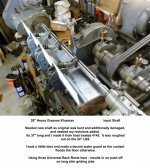jspivey
Aluminum
- Joined
- Nov 18, 2018
- Location
- Southern Illinois
I have a pretty long commute every day and like to use that time to think about interesting things. Recently I’ve been thinking about plain spindle bearings.
Say a person wants to build a relatively small, fast spindle but doesn’t want to pay the premium for actual Timken (or other) spindle bearings. Obviously a plain bearing is much cheaper.
Here are some assumptions:
1: Bearing bore diameter is nominally 2”ID x3” long. Bearing is of appropriate bronze alloy.
2: You have a hardened and polished spindle with appropriate clearance running in the bore.
3: You have a pressurized lube system for the bearing (ie not an oil cup)
4: There is a pressurized coolant system built into the spindle/spindle housing to prevent over heating.
5: Everything is properly aligned.
6: Axial and radial loads will be relatively light (think the kind of force that a small benchtop lathe could handle comfortably)
Everyone knows that older plain bearing lathes have relatively low spindle speeds, but I understand this is because the were expected to have relatively high cutting forces. A “force on spindle vs spindle speed” relationship. Assuming cutting forces are very low, what is the determining factor for spindle speed? Thermal expansion that can be compensated for with a cooling system?
How can one roughly figure the max safe rpm you could run such a spindle at without serious issues?
Say a person wants to build a relatively small, fast spindle but doesn’t want to pay the premium for actual Timken (or other) spindle bearings. Obviously a plain bearing is much cheaper.
Here are some assumptions:
1: Bearing bore diameter is nominally 2”ID x3” long. Bearing is of appropriate bronze alloy.
2: You have a hardened and polished spindle with appropriate clearance running in the bore.
3: You have a pressurized lube system for the bearing (ie not an oil cup)
4: There is a pressurized coolant system built into the spindle/spindle housing to prevent over heating.
5: Everything is properly aligned.
6: Axial and radial loads will be relatively light (think the kind of force that a small benchtop lathe could handle comfortably)
Everyone knows that older plain bearing lathes have relatively low spindle speeds, but I understand this is because the were expected to have relatively high cutting forces. A “force on spindle vs spindle speed” relationship. Assuming cutting forces are very low, what is the determining factor for spindle speed? Thermal expansion that can be compensated for with a cooling system?
How can one roughly figure the max safe rpm you could run such a spindle at without serious issues?



